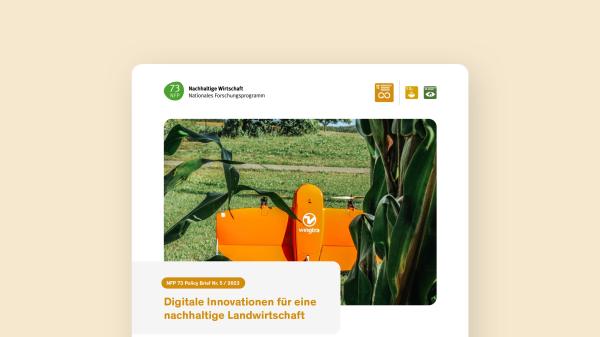Digital innovations for sustainable agriculture
New information and communication technologies have the potential to reduce the environmental footprint of Swiss agriculture without restricting food output. Political support, amongst other things, is needed to realise the potential of precision agriculture.

Background
New digital technologies are making it possible to use agricultural production factors such as fertilisers and plant protection agents with greater precision, thereby increasing the environmental compatibility of farming without reducing food output. A holistic approach to technical, agronomic, and socio-economic factors can generate added value for the Swiss agricultural and agri-food system.
Aims
The aim of the project was to highlight how new information and communication technologies, such as the use of remote sensing (e.g. via satellites or drones), could contribute to the sustainable development of Swiss agriculture. We examined new applications – e.g. in the use of drones – relating to fertiliser usage and quantified their environmental impact. The aim was also to determine the costs and benefits of digital technologies, thereby providing a decision-making basis for management and policy measures.
Results
Nitrogen use in agriculture can be reduced
Our findings from several field trials show that sensors can precisely measure the uneven distribution and emission of nitrogen compounds in the field. Thus information from satellites or drones can help significantly to reduce nitrogen use without affecting yield. The measurements of greenhouse gas emissions also imply that optimised fertiliser application and crop rotation with a high degree of coverage all the year round can have a positive environmental impact.
Demand for reliable precision technologies is increasing
The economic analysis of precision agriculture procedures shows that, although there is financial added value for farmers, this is often too small to justify large investments in digital technologies. However, rising fertiliser prices are making these technologies a more attractive proposition. Cross-enterprise collaboration and state support are also increasing the demand for precision agriculture. Surveys show that Swiss farmers are open to the idea of precision agriculture if the technology is reliable and technical support is available.
Digital innovation calls for a holistic approach
From an agricultural policy point of view, our findings show that a holistic approach is needed to any possible funding of digital innovations in agriculture. There are five key aspects to this:
1) Digital infrastructure needs to be more broadly established.
2) Knowledge of new technologies has to be promoted. This requires training, and dialogue in farming networks.
3) There need to be clear rules on how data from different stakeholders can be used.
4) Since it would not make sense for every farm to make major investments, overarching perspectives are required.
5) Policy measures should not be geared to specific technologies, but explicitly to reducing environmental footprint with no detriment to production.
Implications for research
The interdisciplinary research carried out by the InnoFarm project has shown the importance of taking a holistic view of the challenges posed by new digital technologies. The project made specific technical research contributions in relation to the use of imaging procedures and measured the exchange of gases on arable farmland. Moreover, by linking these findings with agronomic research and incorporating them into agricultural policy deliberations, it was able to highlight new research perspectives for sustainable agriculture.
Implications for practice
The project provides a knowledge base for the use of precision technologies and fertilisers and for crop rotation decisions in Swiss agriculture. However, the findings also show that government must play a key role in realising the environmental and economic potential of these technologies. All stakeholders need to work together to enable new information and communication technologies to play their part in sustainable agriculture.
Publications
Project leaders
Prof. Dr. Robert Finger
Gruppe für Agrarökonomie und -politik, ETH Zürich
Dr. Robert Huber
Gruppe für Agrarökonomie und -politik, ETH Zürich
Prof. Dr. Nina Buchmann
Institut für Agrarwissenschaften, ETH Zürich
Prof. Dr. Achim Walter
Institut für Agrarwissenschaften, ETH Zürich
Project partners
DigiN Project (Agroscope)
European Association of Remote Sensing Laboratories - EARSeL
Nitrogäu Project (FiBL)
SENsing of Scalable ECOphysiological traits – Senseco (COST action)




